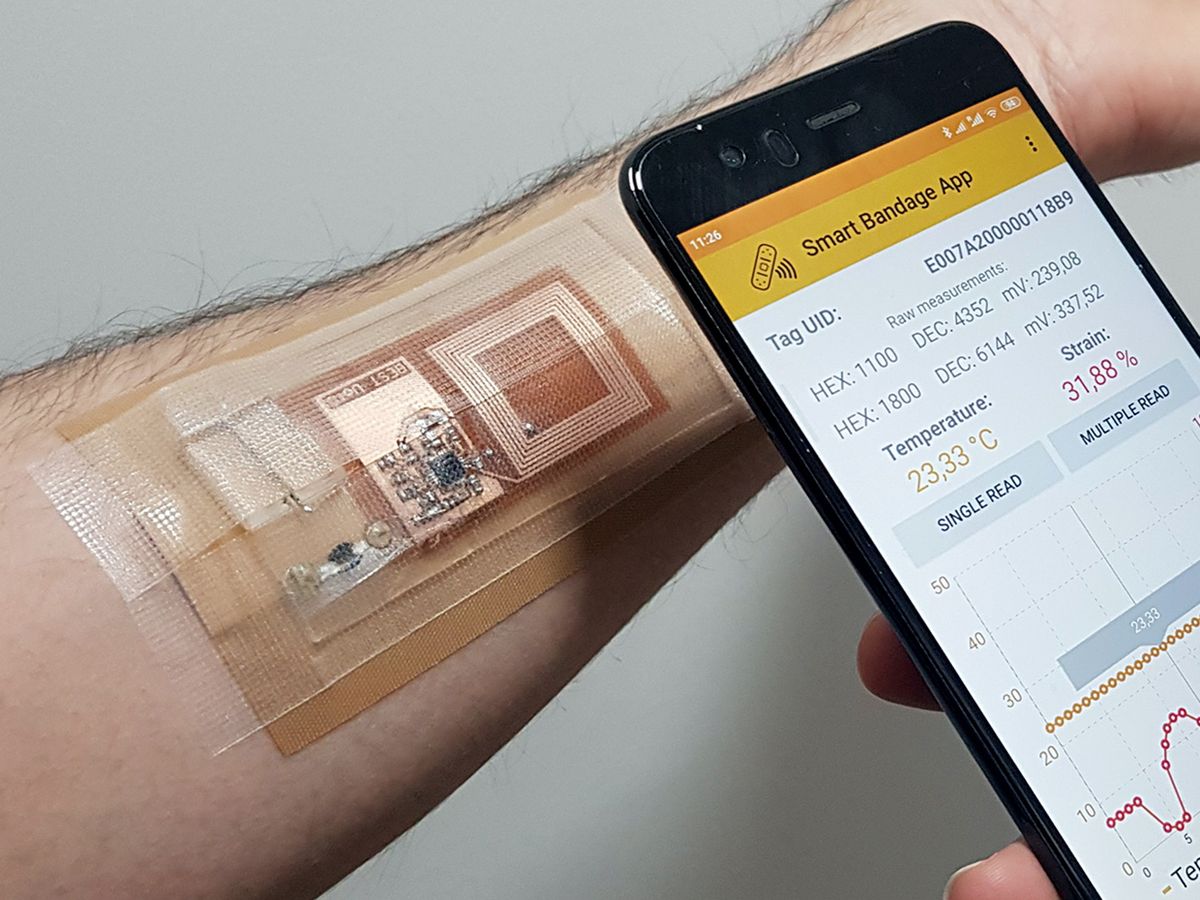THE INSTITUTE Patients with an open wound, such as a bedsore or a foot ulcer, need to be checked frequently to see how well it is healing. That can require regular trips to a doctor’s office. But patients might not have to make as many of those visits, thanks to a new smart bandage developed by IEEE Fellow Ravinder Dahiya and other researchers at the University of Glasgow. Dahiya is with the university’s Bendable Electronics and Sensing Technologies group.
The flexible adhesive patch is 3 centimeters by 6 cm and can be used to apply pressure to help a wound heal. It is the first bandage to use sensors that simultaneously measure how much strain is being put on the skin and the patient’s temperature, which can affect the healing process. The readings from the dressing can be sent to a health care provider via a smartphone app the researchers developed.
Monitoring wound healing isn’t the only potential application. Dahiya says the bandage can be used to monitor breathing and even detect COVID-19 symptoms.
The research was published in the open-access paper “Smart Bandage With Wireless Strain and Temperature Sensors and Batteryless NFC Tag,” which can be downloaded from the IEEE Xplore Digital Library.
“Temperature and strain are two parameters that have hardly ever been combined for wound assessment,” the researchers wrote.

HASTENING HEALING
Various techniques are used to speed up the healing process, including using skin substitutes (for hard-to-heal wounds), as well as electroceuticals with piezoelectric materials–based dressings and negative-pressure therapy, which increase the flow of blood while keeping the wound moist.
“A compression bandage that applies just the right pressure could also hasten healing,” Dahiya says. But figuring out the correct pressure and how to monitor body temperature was a challenge. Studies show that wound healing is best at a body temperature between 36° and 38° C.
The team’s clear, adhesive bandage uses two types of sensors and a batteryless near-field communication (NFC) tag. One sensor monitors the patient’s temperature while the other one checks how much strain is being put on the skin. Transparent polydimethylsiloxane was used to make the strain sensor. PDMS is the most widely used silicon-based organic polymer because of its versatility. The NFC tag transmits the data from the sensors wirelessly to the smartphone app.
The researchers found the strain sensor could determine the right amount of pressure for the compression bandage, and the temperature sensor could detect if the patient is spiking a fever and therefore might have an infection.
MANY USES
Dahiya says the smart bandage also can be used to check the lung functions of those with respiratory conditions such as asthma, as well as people on ventilators. When the patch is placed on the patient’s chest, its strain sensor can detect erratic breathing. He has tested his theory with a mannequin on a ventilator, as seen in this video.
The patch could even be used to help detect coronavirus cases, he said, because two major COVID-19 symptoms are difficulty breathing and a fever. The smart app could immediately notify a health provider, speeding up testing and possibly stopping a sick patient from infecting others.
The bandage has been tested in the lab, and its technology readiness level (TRL) is about a 5, Dahiya says. The TRL system, which can be used to assess a technology’s maturity, has levels that go up to 9. A 5 rating means the technology can be tested outside the lab.
“The smart bandage could be used by just about anybody, especially frontline workers,” Dahiya says. “They are the people who need it most.”
IEEE membership offers a wide range of benefits and opportunities for those who share a common interest in technology. If you are not already a member, consider joining IEEE and becoming part of a worldwide network of more than 400,000 students and professionals.
Kathy Pretz is editor in chief for The Institute, which covers all aspects of IEEE, its members, and the technology they're involved in. She has a bachelor's degree in applied communication from Rider University, in Lawrenceville, N.J., and holds a master's degree in corporate and public communication from Monmouth University, in West Long Branch, N.J.



